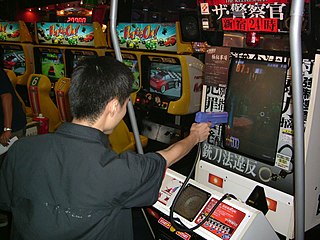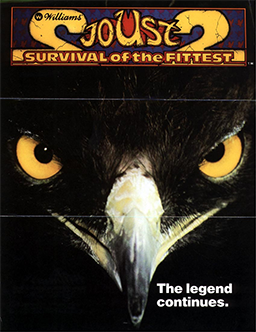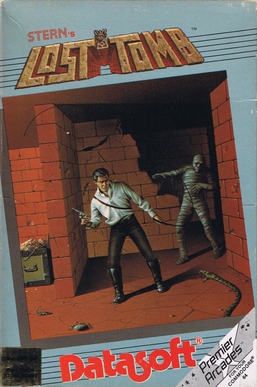
The Intellivision is a home video game console released by Mattel Electronics in 1979. The name is a portmanteau of "intelligent television". Development began in 1977, the same year as the launch of its main competitor, the Atari 2600. In 1984, Mattel sold its video game assets to a former Mattel Electronics executive and investors, eventually becoming INTV Corporation. Game development ran from 1978 to 1990, when the Intellivision was discontinued. From 1980 to 1983, more than 3.75 million consoles were sold. As per Intellivision Entertainment the final tally through 1990 is somewhere between 4.5 and 5 million consoles sold.

An arcade video game takes player input from its controls, processes it through electrical or computerized components, and displays output to an electronic monitor or similar display. All arcade video games are coin-operated or accept other means of payment, housed in an arcade cabinet, and located in amusement arcades alongside other kinds of arcade games. Until the early 2000s, arcade video games were the largest and most technologically advanced segment of the video game industry.

Joust is an action game developed by Williams Electronics and released in arcades in 1982. While not the first two-player cooperative video game, Joust's success and polished implementation popularized the concept. Players assume the role of knights armed with lances and mounted on large birds, who must fly around the screen and defeat enemy knights riding buzzards.

Noah Falstein is a game designer and producer who has been in the video game industry since 1980, winning "Game of the Year" titles for multiple games such as Battlehawks 1942 and Indiana Jones and the Fate of Atlantis. He has designed games for multiple platforms, including arcade video games, Commodore 64, and MS-DOS.

Defender is a horizontally scrolling shooter video game developed by Williams Electronics in 1980 and released for arcades in 1981. The game is set on either an unnamed planet or city where the player must defeat waves of invading aliens while protecting astronauts. Development was led by Eugene Jarvis, a pinball programmer at Williams; Defender was Jarvis's first video game project and drew inspiration from Space Invaders and Asteroids. Defender was demonstrated in late 1980, before entering production in early 1981. It was distributed in Japan by Taito.

The Nintendo VS. System is an arcade system developed and produced by Nintendo from 1984 to 1990. It is based on most of the same hardware as the Family Computer (Famicom), later released as the Nintendo Entertainment System (NES). As Nintendo was planning to release the NES in North America, they were aware of the video game crash of 1983 and its effects on the home console market. However by March 1984 the arcade industry recovered enough for a plan to introduce NES titles there, with the VS. System later being a presentation to players who did not yet own the console. It became the first version of the Famicom hardware to debut in North America.

In computer graphics, a sprite is a two-dimensional bitmap that is integrated into a larger scene, most often in a 2D video game. Originally, the term sprite referred to fixed-sized objects composited together, by hardware, with a background. Use of the term has since become more general.
Sinistar is a 1983 multidirectional shooter arcade game developed and manufactured by Williams Electronics. It was created by Sam Dicker, Jack Haeger, Noah Falstein, RJ Mical, Python Anghelo, and Richard Witt. Players control a space pilot who battles the eponymous Sinistar, a giant, anthropomorphic spacecraft. The game is known for its use of digitized speech and high difficulty level.

Joust 2: Survival of the Fittest is an arcade game developed by Williams Electronics and released in 1986. It is a sequel to Williams' 1982 game Joust. Like its predecessor, Joust 2 is a 2D aerial combat game with platforms to land on. The player uses a button and joystick to control a knight riding a flying ostrich. The object is to progress through levels by defeating groups of enemy knights riding buzzards. Joust 2 features improved audio-visuals and new features such as mutant buzzards created by eggs falling into lava, the ability to transform from an ostrich to a flying horse, and differently themed levels. Waves no longer seamlessly flow into each other; the gameplay is divided into separate screens with transitions between them.
In video gaming parlance, a conversion is the production of a game on one computer or console that was originally written for another system. Over the years, video game conversion has taken form in a number of different ways, both in their style and the method in which they were converted.
Blaster is a first-person rail shooter video game, released for arcades by Williams Electronics in 1983. It was developed by Eugene Jarvis and Larry DeMar. A vague sequel to Robotron: 2084, the game is a shoot 'em up set in outer space. The goal is to destroy enemies, avoid obstacles, and rescue astronauts in twenty levels, to reach paradise.

Bubbles is a 2D action game developed by Williams Electronics and released arcades in 1982. The player uses a joystick to control a bubble in a kitchen sink. The object is to progress through levels by cleaning the sink while avoiding enemies.

Williams Arcade's Greatest Hits is a video game anthology for the Super Nintendo Entertainment System, PlayStation, Sega Genesis, Saturn, Game.com, Dreamcast, MS-DOS, and Microsoft Windows. The IBM PC compatible and game.com versions are titled Williams Arcade Classics, while the Saturn version was titled Midway Presents Arcade's Greatest Hits. The 2000 release Midway's Greatest Arcade Hits Vol. 1 contains much of the same content.

Oh My God! is an arcade puzzle game from Atlus. The gameplay is similar to a cross between Columns and Snake.
The Williams Pinball Controller (WPC) is an arcade system board platform used for several pinball games designed by Williams and Midway between 1990 and early 1999. It is the successor to their earlier System 11 hardware. It was succeeded by Williams/Midway's Pinball 2000 platform, before Williams left the pinball business in October 1999.

Star Rider is a racing LaserDisc video game developed by Computer Creations and Williams Electronics, and released for arcades in 1983. The object of the game is to win a futuristic motorcycle race that takes place in surrealistic settings. The tracks themselves and the background graphics are video played from a laserdisc, and are of higher quality than possible with real-time computer graphics at the time. The foreground graphics and racers are superimposed on the video. Star Rider has a rear view mirror—possibly the first racing game with one —which warns of opponents approaching from behind.
Atari System refers to two arcade system boards introduced in 1984 for use in various arcade games from Atari Games. Two versions of the board were released, Atari System 1 and Atari System 2.
Python Vladimir Anghelo was a graphic artist best known for his work on video games and pinball machines. Anghelo was born in Transylvania, Romania, and moved to the United States when he was 17.

Fantasy is an action game developed by SNK and released for arcades in October 1981. It was licensed to Rock-Ola for North American release in February 1982. The game is controlled with a single joystick. One level plays the melody from the song "Funkytown". According to the book Gamers: Writers, Artists & Programmers on the Pleasures of Pixels, this is the first arcade video game to have a continue feature.

Lost Tomb is an overhead-view twin-stick shooter written by Dan Lee and released as an arcade video game by Stern Electronics in 1982. Armed with a gun and whip, the player uses dual joysticks to explore the chambers of a South American pyramid looking for treasure and fighting mummies, spiders, and scorpions. The game was Stern's first arcade conversion kit and was intended for use with earlier machines from the company.













